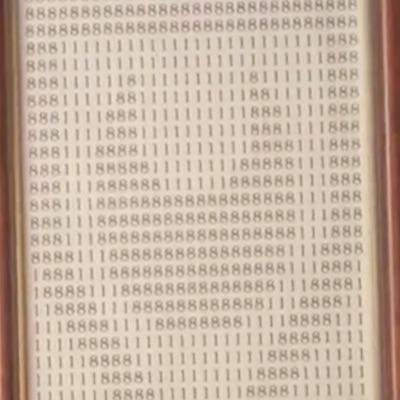Primal urge
28 Sep 2017

I love this video from Numberphile about a prime number with 1,350 digits (and some other special visual properties).
I can’t believe I studied at Trinity Hall for four years and didn’t know about this. A custom prime number with the college emblem “ASCII art”-ed inside it? What could appeal more to my geeky brain? I’m enjoying all the Numberphile videos.
Within a very short time the number had been extracted from the video and other clever people had been inspired to post creative and original responses. I’m slower off the mark - but I couldn’t resist coming up with some reasonably big and meaningful prime numbers of my “own”. (quotation marks because I don’t feel like a person can own a number)
Here are two prime numbers depicting the logos of the companies I work for. You have to squint a bit on most screens to see ‘em. And if the lines are wrapping, no amount of squinting is going to help: just look on a bigger screen, or try landscape.
First, the Angent prime:
88888888888888888888881111118888888888888888888888
88888888888888888881111111111118888888888888888888
88888888888888888111111111111111188888888888888888
88888888888888881111111111111111118888888888888888
88888888888888811111111111111111111888888888888888
88888888888888111111118888881111111188888888888888
88888888888888111118888111188881111188888888888888
88888888888881111188811111111888111118888888888888
88888888888881111888111111111188811118888888888888
88888888888811111188811111111888111111888888888888
88888888888811111118888111188881111111888888888888
88888888888111111111188888888111111111188888888888
88888888881111111111111111111111111111118888888888
88888888111111111111111111111111111111111188888888
88888111111111111111111111111111111111111111188888
11111111111111111111188888888111111111111111111111
11111111111111111118888888888881111111111111111111
11111111111111111888888888888888811111111111111111
11111111111111118888888888888888881111111111111111
11111111111111888888888888888888888811111111111111
00000000000000000000000000000000000000000000000000
00000000000000000000000000000000000000000000000621
and for dessert, the Owlstone prime, which requires a slightly ‘deeper’ squint:
111111111111118111111111111111111111111111111
111111111111118881111111111111111111111111111
111111111111111888888111111111111111111111111
111111111111888111118888811111111111111111111
111111111118881111111111111111111111111111111
111111111188811111111111111111111111111111111
111111111111111111111111111111188811111111111
111111111111111111111111111111111111111111111
111111111111111111111111111111111111111111111
111111111111111111111111111111111111111111111
111111111111111111111111111111111111111111111
111111111111111111111111188888888111111111111
111111118111111111188888888888888888811111111
188111888111111111111111888888888888888111111
188118888111111111111111111888888888888881111
881118888811111111111111111111888888888888111
881118888811111111111111111111188888888888811
888118888881111111111111111111118888888888811
888111888881111111111111111111111888888888811
188111188888111111111111111111111188888888811
118811111888811111111111111111111188811888811
111881111188881111111111111111111111111888111
111181111111888811111111111111111111111888111
111111111111118881111111111111111111111881111
111111111111111118811111111111111111118811111
111111111111111111111111111111111111118811111
111111111111111111111111111111111111188111111
111111111111111111111111111111111111181111111
111111111111111111111111111111111111111111111
111111111111111111111111111111111111111114027
By accident, this second prime has 1,350 digits, just like Professor McKee’s. These are less beautiful, to me at least. Partly that’s because I just used computer to find them and check them - the work of a few minutes - and partly because I merely followed in the footsteps.
One thing I’ve shared, however, is my working. Always show your working, eh? Python notebook here for the interested, and feel free to use the code if you’d like to find your own:
One final word: primality Testing with the Rabin-Miller Algorithm is only probabilistic. I’m sure you knew that. Check your primes.
< Previous post | Next post >Favourite posts
- On wiggly lines and being normal
- On infinite villages
- Running a race backwards
- Brainmaking
- Their tables were stored full, to glad the sight
- The structure of a smell
Recent posts
- Start your holidays with a meta-alarm
- PGN files from handwritten chess notation
- Souvenirs des villes européennes
- Pic'n'mix reinvented
- Super slow-mo Tetris
Blog archives
Posts from 2012, 2013, 2014, 2015, 2016, 2017, 2018, 2019, 2020, 2021, 2022, 2023, 2024.